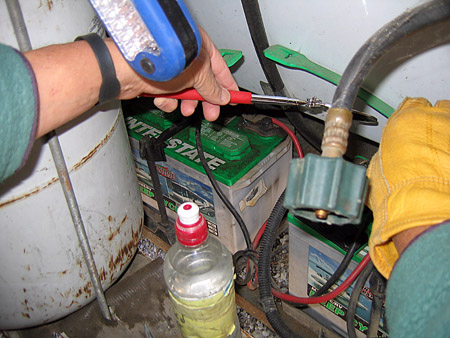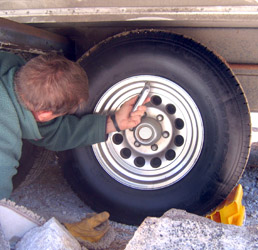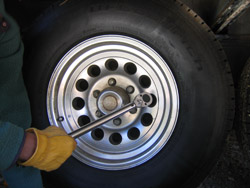By Barry Zander, Edited by Monique Zander, the Never-Bored RVers
The winds are bringing in more of a chill. November is getting closer, and before that, of course, many of you snowbirds are excited about watching your grandkids go trick-or-treating.
In this episode of “Getting Ready “for your fall travels,” I’ll remind you of what I consider to be the most important tasks for trailer/5th wheel pullers – checking the battery and tires. For you motorhome, C Class and truck camper drivers, I would imagine having the engine checked over would be just as important, and getting it done at home from mechanics that you trust is probably a better alternative than hoping for a reliable mechanic a long way down the road.
But first, let me pass along a note from RV expert Mark Polk about putting grease on slide bars:
Hi Barry,
There are lots of slide-out manufacturers and various slide-out control mechanisms. If at all possible it’s best to follow the advice of the slide manufacturer for maintenance procedures, intervals and lubrication techniques. If the unit is under warranty it’s important that you use what the manufacturer recommends for lubricating the slide-out.
The owner should look through the owner’s manual for information on the slide-out. Many times it is possible to contact the manufacturer through a tech email or phone contact and get answers directly from them about their products.
With that said, the majority of slide mechanisms call for a dry lubricant so you avoid attracting dirt and debris, which can lead to problems down the road. There are lubricating products that are designed specifically for slide-out mechanisms and sold through RV dealerships and [Camping World]. I like to use a product called Boeshield T9 for the majority of jobs that require lubrication on RVs.
Hope this answers your question.
Mark Polk[www.rveducation101.com]
BATTERIES & TIRES
Yesterday I opened the hatch to access the batteries and immediately realized that Halloween was upon us … obvious from the spider webs decorating the compartment that houses

A lot of maneuvering, but a necessary task every two weeks. For me, tough to get to; for Monique, tough to photograph.
both our propane tanks and batteries.
This task always reminds me again that there are no perfect RVs. While we’re glad to voice praises for our 2008 Bigfoot, the tight quarters to check the batteries are not usually mentioned. (The Bigfoot company went through hard times, and has now rebounded, but the new owners haven’t added our 28-foot model to their inventory.)
In our rig, to reach the batteries, I remove the propane tanks and then squirm around until I can position myself to use a mirror to look inside. I know you don’t want to hear my problems, but about a year ago I wrote about trying to replace our 12-volt batteries with 6-volters. After hours of effort to get the batteries and removing the old batteries, our mechanic realized that there wasn’t enough space to check and add distilled water to the new ones. We were hitched up and traveling about two hours later.
Our situation “is what it is,” but I welcome your comments below about servicing your batteries.

Another ordeal, getting under the slide to check air pressure. The good news is they are holding air since the last check.
Finally, for this series, it’s time to check tires. Crawling under the slide to check the left-side tires is an exercise in agility, but I’m pretty good about checking them every two weeks when we on the move. Not torqueing the lugs on a regular basis is a recipe for disaster – a lug nut that gets loose can mean a long layover while repairs are made. I’ve also heard of a car alongside the RV hit by a lug nut into the windshield.

Getting ready to apply the torque wrench.
November is near, which means we’ll be seeing a steady stream of rigs heading south. It’s a fascinating phenomenon, which I’m inclined to compare to ants on the countertop.
I’ve covered what I can think of as basic preparation for winter travels. I’m open to learn more from you, the blog readers, and this is a blog you might want to check again in a week to see any new information that has been added in the Comments Section.
BEFORE SIGNING OFF, since I posted a correction above to my erroneous suggestion that white lithium grease be applied to the slide, I’ll reply to three comments from the past.
While getting ready for our Alaska caravan, I received the following comment to a blog written about how to best utilize the space in your rig/tow vehicle. “You really need to get your stuff together. Rather than reducing the [expletive], you have found ways to keep it all. What are you thinking? Get rid of it!!! We traveled all over Europe for ten years in a converted Mercedes 3 ton van. 4 cylinder diesel and we never lacked for room, because we left IT all at home. “
I didn’t take issue with that then, but on behalf of all full-time RVers, I wanted to remind the writer that you can’t leave the [expletive] at home if your home is on wheels behind you.
More recently, in the August issue of “Trailer Life” there was a letter to the editor in response to my column about the cost of full-timing http://www.trailerlife.com/rv-trailer-news/what-will-full-timing-cost-you/. The writer explained that full-timers get their insurance policy cancelled and can’t get financing to purchase an RV. I called the insurance and financing arms of a company called “Good Sam” — the sponsor of rv.net and publisher of Trailer Life — and learned that they are glad to insure and finance rigs for full-timers. (I didn’t check with any other companies for their policies.)
I also want to respond to a writer who mentioned that getting the biggest rig you can afford is the way to RV. That is a preference of many RVers, but things like limitations on rig size at public campgrounds and cost of fuel are other factors to consider when in the market.
Glad to get those things off my chest.
From the “Never-Bored RVers,” We’ll see you on down the road.
© All photos by Monique Zander. All rights reserved
Richard Bartelt
Batteries and propane tanks in the same compartment ??????????
John Dough
Buy the largest RV you can afford has a downside.
Our RV club has 57 rigs. 34 – Class A’s (59.6%), 3 – Class B’s (5.2%), 1 Class C (1.2%), 9 – 5th wheels (15.7%), 9 – Travel trailers (15.7%) and the remainder in pop-ups (1.2%).
There isn’t a club rally that doesn’t go by where an owner of a huge fancy 40′ Class A doesn’t enter my Cougar Travel trailer, marveling on it’s decor and wishing he hadn’t spent so much on his “land yacht”. We’ve seen 4 members sell their Class A’s and buy 5th wheels and Travel Trailers in the last year.
Mostly the maintenance issue kills the Class A owners and they don’t like having to own a “Toad” to drag around behind them. Mostly they are small “critters” that don’t offer them a usable vehicle when not traveling.
BTW Barry, My TT batteries on mounted on the trailer tongue.Easy access.
Thewbje
I went to sealed AGM batteries —no water to add and they can be installed in any position
Steve Varadi
Regarding the batteries water level, I had the same situation as yours. I found a solution Flow-Rite MP-2000 Qwick-fill here is one seller:
http://www.rvplus.com/flow-rite-qwik-fill-battery-watering-system-double-mp-2000.html?utm_source=googlepla&utm_medium=cse&utm_content=NT-19-0700&utm_campaign=googlepla&gclid=CPWCq7LjmrMCFW1yQgodWD4A5w
I paid twice as much in campingWorld.
I hope this will help you also.
Steve
Kirk E Coats
I’ll no longer be thinking how tough I have it checking out my battery and propane tanks after seeing yours. Occaisionaly we don’t know how good we have it til we see what others go through. Curious why your slide isn’t closed when you are checking tires and wheels?